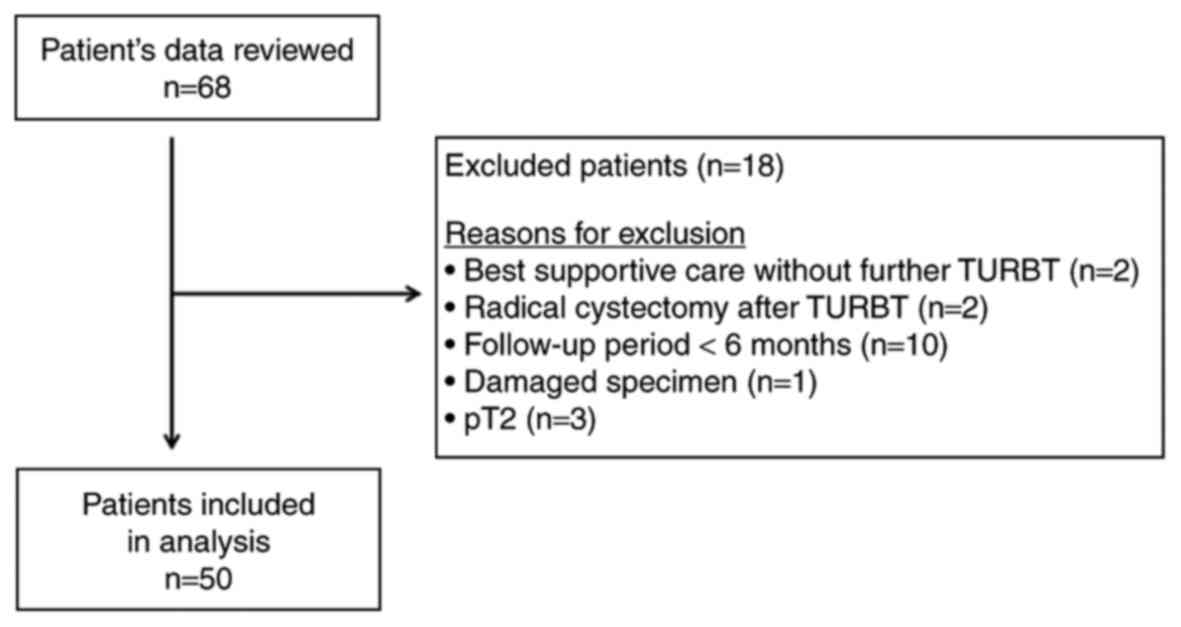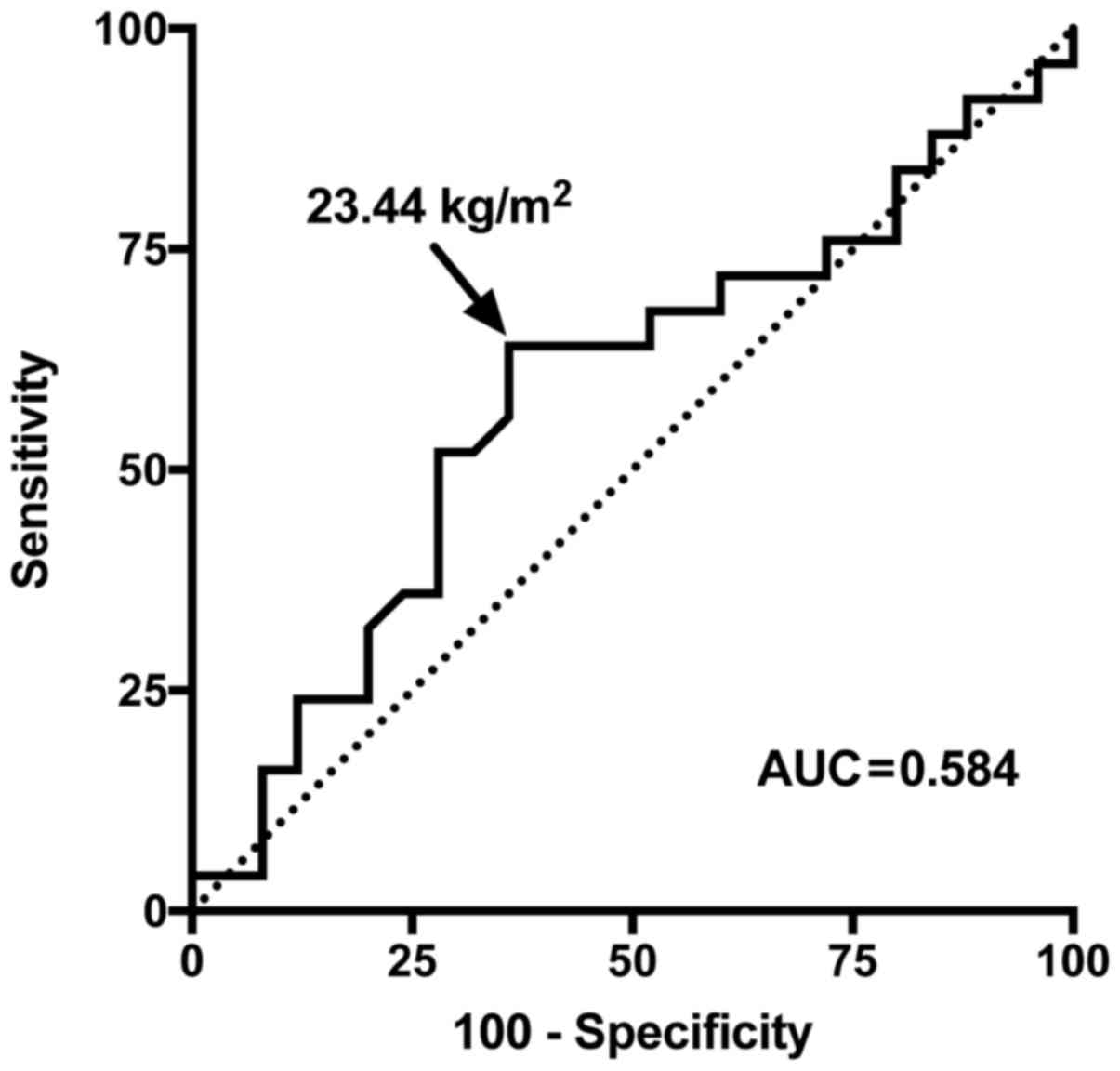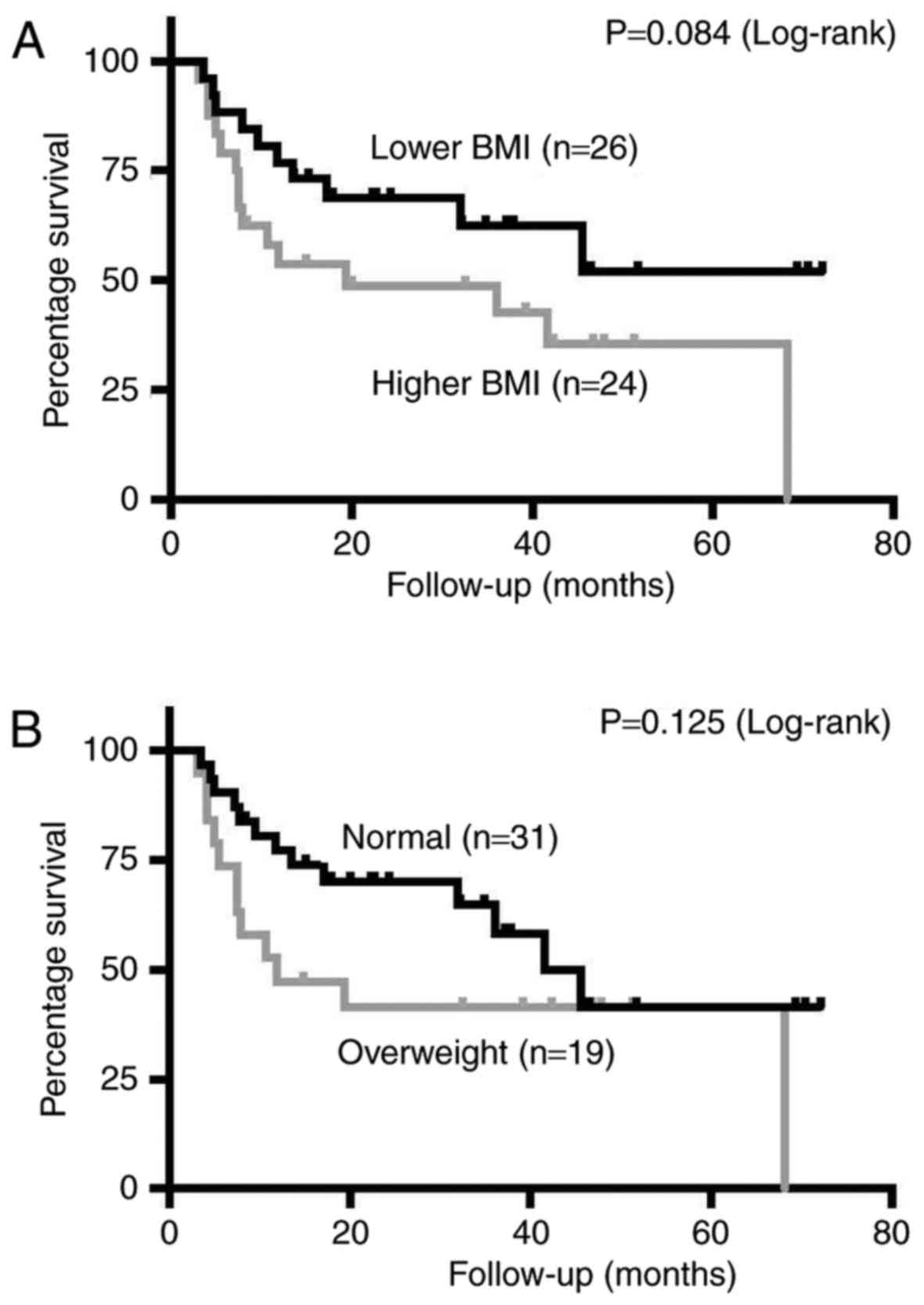|
1
|
Parkin DM, Bray F, Ferlay J and Pisani P:
Global cancer statistics, 2002. CA Cancer J Clin. 55:74–108. 2005.
View Article : Google Scholar : PubMed/NCBI
|
|
2
|
Akaza H: Urologic cancer in Japan: Role of
Japan at the frontier of issues in Asia. Jpn J Clin Oncol.
46:23–30. 2016. View Article : Google Scholar : PubMed/NCBI
|
|
3
|
Babjuk M, Böhle A, Burger M, Capoun O,
Cohen D, Compérat EM, Hernández V, Kaasinen E, Palou J, Rouprêt M,
et al: EAU guidelines on non-muscle-invasive urothelial carcinoma
of the bladder: Update 2016. Eur Urol. 71:447–461. 2017. View Article : Google Scholar : PubMed/NCBI
|
|
4
|
Witjes JA, Compérat E, Cowan NC, De Santis
M, Gakis G, Lebret T, Ribal MJ, Van der Heijden AG and Sherif A:
European Association of Urology: EAU guidelines on muscle-invasive
and metastatic bladder cancer: Summary of the 2013 guidelines. Eur
Urol. 65:778–792. 2014. View Article : Google Scholar : PubMed/NCBI
|
|
5
|
Sylvester RJ, van der Meijden AP,
Oosterlinck W, Witjes JA, Bouffioux C, Denis L, Newling DW and
Kurth K: Predicting recurrence and progression in individual
patients with stage Ta T1 bladder cancer using EORTC risk tables: A
combined analysis of 2596 patients from seven EORTC trials. Eur
Urol. 49(466–465): discussion 475–477. 2016.
|
|
6
|
Miyata Y and Sakai H: Predictive markers
for the recurrence of nonmuscle invasive bladder cancer treated
with intravesical therapy. Dis Markers. 2015:8574162015. View Article : Google Scholar : PubMed/NCBI
|
|
7
|
WHO Expert Consultation: Appropriate
body-mass index for Asian populations and its implications for
policy and intervention strategies. Lancet. 363:157–163. 2004.
View Article : Google Scholar : PubMed/NCBI
|
|
8
|
Chromecki TF, Cha EK, Fajkovic H, Rink M,
Ehdaie B, Svatek RS, Karakiewicz PI, Lotan Y, Tilki D, Bastian PJ,
et al: Obesity is associated with worse oncological outcomes in
patients treated with radical cystectomy. BJU Int. 111:249–255.
2013. View Article : Google Scholar : PubMed/NCBI
|
|
9
|
Dabi Y, Rouscoff Y, Anract J, Delongchamps
NB, Sibony M, Saighi D, Zerbib M, Peyraumore M and Xylinas E:
Impact of body mass index on the oncological outcomes of patients
treated with radical cystectomy for muscle-invasive bladder cancer.
World J Urol. 35:229–235. 2017. View Article : Google Scholar : PubMed/NCBI
|
|
10
|
da Silva RD, Xylinas E, Kluth L, Crivelli
JJ, Chrystal J, Chade D, Guglielmetti GB, Pycha A, Lotan Y,
Karakiewicz PI, et al: Impact of statin use on oncologic outcomes
in patients with urothelial carcinoma of the bladder treated with
radical cystectomy. J Urol. 190:487–492. 2013. View Article : Google Scholar : PubMed/NCBI
|
|
11
|
Osawa T, Lee CT, Abe T, Takada N, Hafez
KS, Montgomery JS, Weizer AZ, Hollenbeck BK, Skolarus TA, Murai S,
et al: A multi-center international study assessing the impact of
differences in baseline characteristics and perioperative care
following radical cystectomy. Bladder Cancer. 2:251–261. 2016.
View Article : Google Scholar : PubMed/NCBI
|
|
12
|
Kluth LA, Xylinas E, Crivelli JJ, Passoni
N, Comploj E, Pycha A, Chrystal J, Sun M, Karakiewicz PI, Gontero
P, et al: Obesity is associated with worse outcomes in patients
with T1 high grade urothelial carcinoma of the bladder. J Urol.
190:480–486. 2013. View Article : Google Scholar : PubMed/NCBI
|
|
13
|
Wyszynski A, Tanyos SA, Rees JR, Marsit
CJ, Kelsey KT, Schned AR, Pendleton EM, Celaya MO, Zens MS, Karagas
MR and Andrew AS: Body mass and smoking are modifiable risk factors
for recurrent bladder cancer. Cancer. 120:408–414. 2014. View Article : Google Scholar : PubMed/NCBI
|
|
14
|
Xu T, Zhu Z, Wang X, Xia L, Zhang X, Zhong
S, Sun F, Zhu Y and Shen Z: Impact of body mass on recurrence and
progression in Chinese patients with Ta, T1 urothelial bladder
cancer. Int Urol Nephrol. 47:1135–1141. 2015. View Article : Google Scholar : PubMed/NCBI
|
|
15
|
Freedman ND, Silverman DT, Hollenbeck AR,
Schatzkin A and Abnet CC: Association between smoking and risk of
bladder cancer among men and women. JAMA. 306:737–745. 2011.
View Article : Google Scholar : PubMed/NCBI
|
|
16
|
Golka K, Wiese A, Assennato G and Bolt HM:
Occupational exposure and urological cancer. World J Urol.
21:382–391. 2004. View Article : Google Scholar : PubMed/NCBI
|
|
17
|
Pedersen-Bjergaard J, Ersbøll J, Hansen
VL, Sørensen BL, Christoffersen K, Hou-Jensen K, Nissen NI, Knudsen
JB and Hansen MM: Carcinoma of the urinary bladder after treatment
with cyclophosphamide for non-Hodgkin's lymphoma. N Engl J Med.
318:1028–1032. 1988. View Article : Google Scholar : PubMed/NCBI
|
|
18
|
Sountoulides P, Koletsas N, Kikidakis D,
Paschalidis K and Sofikitis N: Secondary malignancies following
radiotherapy for prostate cancer. Ther Adv Urol. 2:119–125. 2010.
View Article : Google Scholar : PubMed/NCBI
|
|
19
|
Novara G, De Marco V, Dalpiaz O, Gottardo
F, Bouygues V, Galfano A, Martignoni G, Patard JJ, Artibani W and
Ficarra V: Independent predictors of metachronous bladder
transitional cell carcinoma (TCC) after nephroureterectomy for TCC
of the upper urinary tract. BJU Int. 101:1368–1374. 2008.
View Article : Google Scholar : PubMed/NCBI
|
|
20
|
Montironi R and Lopez-Beltran A: The 2004
WHO classification of bladder tumors: A summary and commentary. Int
J Surg Pathol. 13:143–153. 2005. View Article : Google Scholar : PubMed/NCBI
|
|
21
|
Nechuta S, Chen WY, Cai H, Poole EM, Kwan
ML, Flatt SW, Patterson RE, Pierce JP, Caan BJ and Shu Ou X: A
pooled analysis of post-diagnosis lifestyle factors in association
with late estrogen-receptor-positive breast cancer prognosis. Int J
Cancer. 138:2088–2097. 2016. View Article : Google Scholar : PubMed/NCBI
|
|
22
|
Warren LE, Ligibel JA, Chen YH, Truong L,
Catalano PJ and Bellon JR: Body mass index and locoregional
recurrence in women with early-stage breast cancer. Ann Surg Oncol.
23:3870–3879. 2016. View Article : Google Scholar : PubMed/NCBI
|
|
23
|
Kwan ML, Chen WY, Kroenke CH, Weltzien EK,
Beasley JM, Nechuta SJ, Poole EM, Lu W, Holmes MD, Quesenberry CP
Jr, et al: Pre-diagnosis body mass index and survival after breast
cancer in the after breast cancer pooling project. Breast Cancer
Res Treat. 132:729–739. 2012. View Article : Google Scholar : PubMed/NCBI
|
|
24
|
Wang J, Yang DL, Chen ZZ and Gou BF:
Associations of body mass index with cancer incidence among
populations, genders, and menopausal status: A systematic review
and meta-analysis. Cancer Epidemiol. 42:1–8. 2016. View Article : Google Scholar : PubMed/NCBI
|
|
25
|
Barrington WE, Schenk JM, Etzioni R,
Arnold KB, Neuhouser ML, Thompson IM Jr, Lucia MS and Kristal AR:
Difference in association of obesity with prostate cancer risk
between US African American and non-hispanic white men in the
selenium and vitamin E cancer prevention trial (SELECT). JAMA
Oncol. 1:342–349. 2015. View Article : Google Scholar : PubMed/NCBI
|
|
26
|
Cao Y and Ma J: Body mass index, prostate
cancer-specific mortality, and biochemical recurrence: A systematic
review and meta-analysis. Cancer Prev Res (Phila). 4:486–501. 2011.
View Article : Google Scholar : PubMed/NCBI
|
|
27
|
Haque R, Van Den Eeden SK, Wallner LP,
Richert-Boe K, Kallakury B, Wang R and Weinmann S: Association of
body mass index and prostate cancer mortality. Obes Res Clin Pract.
8:e374–e381. 2014. View Article : Google Scholar : PubMed/NCBI
|
|
28
|
Cantarutti A, Bonn SE, Adami HO, Grönberg
H, Bellocco R and Bälter K: Body mass index and mortality in men
with prostate cancer. Prostate. 75:1129–1136. 2015. View Article : Google Scholar : PubMed/NCBI
|
|
29
|
Inamoto T, Komura K, Watsuji T and Azuma
H: Specific body mass index cut-off value in relation to survival
of patients with upper urinary tract urothelial carcinomas. Int J
Clin Oncol. 17:256–262. 2012. View Article : Google Scholar : PubMed/NCBI
|
|
30
|
Bao PP, Cai H, Peng P, Gu K, Su Y, Shu XO
and Zheng Y: Body mass index and weight change in relation to
triple-negative breast cancer survival. Cancer Causes Control.
27:229–236. 2016.ç. View Article : Google Scholar : PubMed/NCBI
|
|
31
|
Demark-Wahnefried W, Platz EA, Ligibel JA,
Blair CK, Courneya KS, Meyerhardt JA, Ganz PA, Rock CL, Schmitz KH,
Wadden T, et al: The role of obesity in cancer survival and
recurrence. Cancer Epidemiol Biomarkers Prev. 21:1244–1259. 2012.
View Article : Google Scholar : PubMed/NCBI
|
|
32
|
Richman EL, Kenfield SA, Stampfer MJ,
Paciorek A, Carroll PR and Chan JM: Physical activity after
diagnosis and risk of prostate cancer progression: Data from the
cancer of the prostate strategic urologic research endeavor. Cancer
Res. 71:3889–3895. 2011. View Article : Google Scholar : PubMed/NCBI
|
|
33
|
Meyerhardt JA, Giovannucci EL, Ogino S,
Kirkner GJ, Chan AT, Willett W and Fuchs CS: Physical activity and
male colorectal cancer survival. Arch Intern Med. 169:2102–2108.
2009. View Article : Google Scholar : PubMed/NCBI
|
|
34
|
Holmes MD, Chen WY, Feskanich D, Kroenke
CH and Colditz GA: Physical activity and survival after breast
cancer diagnosis. JAMA. 293:2479–2486. 2005. View Article : Google Scholar : PubMed/NCBI
|
|
35
|
Meyerhardt JA, Giovannucci EL, Holmes MD,
Chan AT, Chan JA, Colditz GA and Fuchs CS: Physical activity and
survival after colorectal cancer diagnosis. J Clin Oncol.
24:3527–3534. 2006. View Article : Google Scholar : PubMed/NCBI
|
|
36
|
Kenfield SA, Stampfer MJ, Giovannucci E
and Chan JM: Physical activity and survival after prostate cancer
diagnosis in the health professionals follow-up study. J Clin
Oncol. 29:726–732. 2011. View Article : Google Scholar : PubMed/NCBI
|
|
37
|
Keimling M, Behrens G, Schmid D, Jochem C
and Leitzmann MF: The association between physical activity and
bladder cancer: Systematic review and meta-analysis. Br J Cancer.
110:1862–1870. 2014. View Article : Google Scholar : PubMed/NCBI
|
|
38
|
Ozbek E, Otunctemur A, Dursun M, Koklu I,
Sahin S, Besiroglu H, Erkoc M, Danis E and Bozkurt M: Association
between the metabolic syndrome and high tumor grade and stage of
primary urothelial cell carcinoma of the bladder. Asian Pac J
Cancer Prev. 15:1447–1451. 2014. View Article : Google Scholar : PubMed/NCBI
|
|
39
|
Bianchini F, Kaaks R and Vainio H:
Overweight, obesity, and cancer risk. Lancet Oncol. 3:565–574.
2002. View Article : Google Scholar : PubMed/NCBI
|
|
40
|
Ohara M, Akimoto E, Noma M, Matsuura K,
Doi M, Kagawa N and Itamoto T: Prognostic impact of progesterone
receptor status combined with body mass index in breast cancer
patients treated with adjuvant aromatase inhibitor. Oncol Lett.
10:3286–3292. 2015. View Article : Google Scholar : PubMed/NCBI
|
|
41
|
Roudnicky F, Dieterich LC, Poyet C, Buser
L, Wild P, Tang D, Camenzind P, Ho CH, Otto VI and Detmar M: High
expression of insulin receptor on tumor-associated blood vessels in
invasive bladder cancer predicts poor overall and progression-free
survival. J Pathol. 242:193–205. 2017. View Article : Google Scholar : PubMed/NCBI
|
|
42
|
Gonzalez MC, Pastore CA, Orlandi SP and
Heymsfield SB: Obesity paradox in cancer: New insights provided by
body composition. Am J Clin Nutr. 99:999–1005. 2014. View Article : Google Scholar : PubMed/NCBI
|












